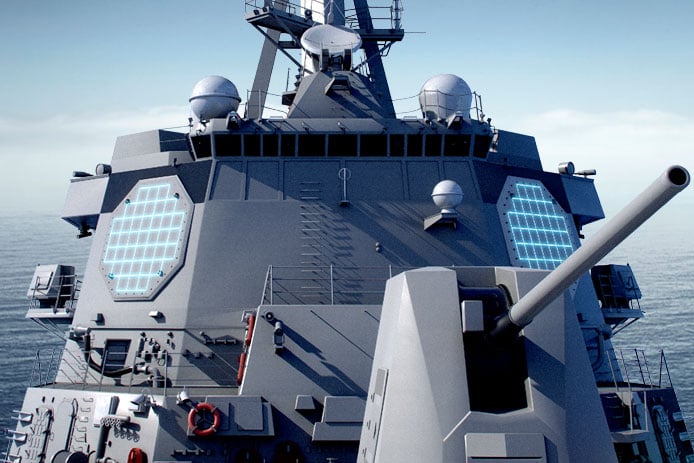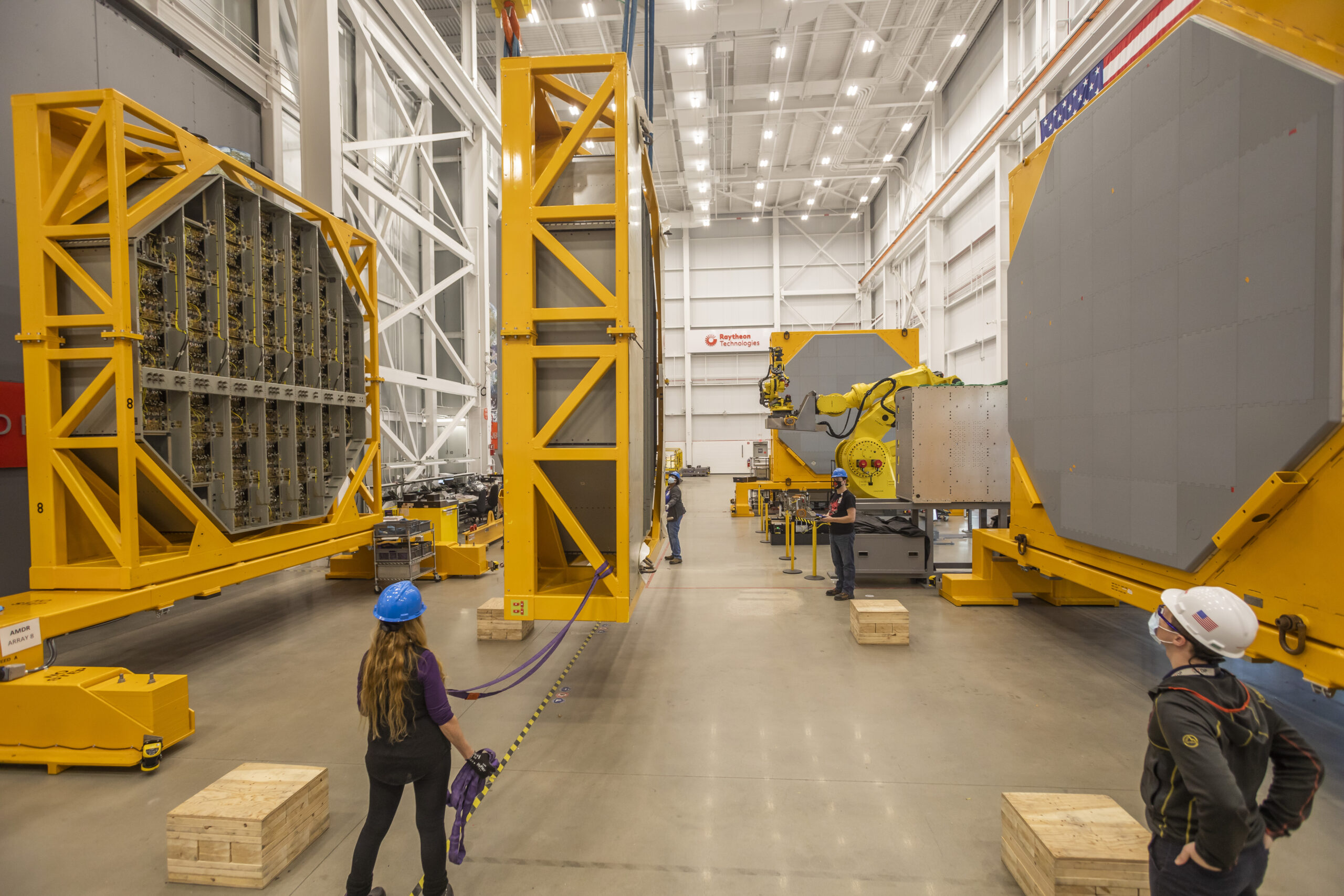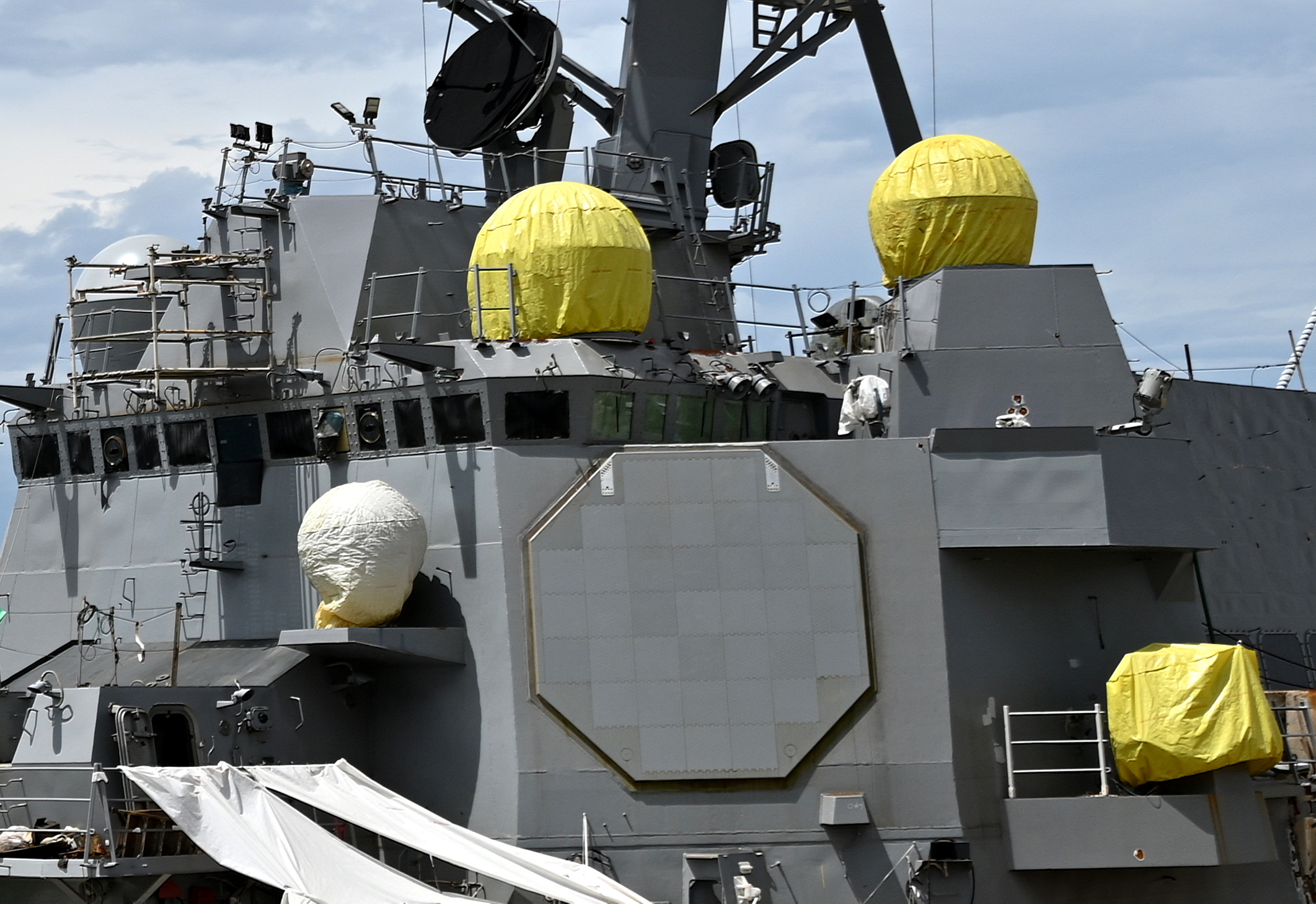
SPY-6 radars can simultaneously track both air breathing targets and ballistic missiles.
One of the challenges for the Defense Department in its quest for distributed operations is addressing the reality that legacy systems were not built with modularity, scalability, and connectivity to meet new and evolving threats from near-peer and peer competitors.
Because of one very big reason, however, that will be less of a challenge for the US Navy’s newest and most advanced weapon systems — the Arleigh Burke-class Flight III destroyer, upgraded Flight IIA destroyers, the under-development Constellation class guided-missile frigate, and the Gerald R. Ford-class nuclear-powered aircraft carrier.
That reason is because all of those warships will all be equipped with the AN/SPY-6(V) S-band radar built by Raytheon Missiles & Defense (RMD).
SPY-6 has capabilities that are directly applicable to the Great Power competition and to new concepts of operation such as Joint All Domain Command and Control (JADC2) and the Navy’s Distributed Maritime Operations (DMO). It can defend against ballistic missiles, cruise missiles, hypersonics, hostile aircraft, and surface ships simultaneously, while offering many advantages over legacy radars, such as greater detection range, increased sensitivity, and more accurate discrimination.
“It’s important to get this out to the fleet as quickly as possible because SPY-6 is a game changer as it relates to the Great Power competition and new, advanced threats that are coming down the pike,” said Scott Spence, executive director of naval radars for the Naval Power Mission area at RMD.
The ability of the SPY-6 family of radars to meet today’s new threats is due to both its modular and scalable hardware and its software-defined backbone.
On the hardware side, the SPY-6 generates more radar energy and has more sensitive receivers than previous-generation radars. That translates into significantly advanced sensitivity for tracking of objects at much farther distances.
“What SPY-6 gives you is the ability to work what we call ‘integrated air and missile defense’ to simultaneously track both air breathing targets, whether it’s cruise missiles or other air breathing threats, and ballistic missiles for the fleet,” said Spence. “The increased sensitivity and versatility of the radar give the Navy much better situational awareness throughout its area of responsibility, which is an important capability for Distributed Maritime Operations.”
Spence also noted that RMD is working with the Office of Naval Research to transmit SPY-6-generated radar data between ships and to share radar energy between individual ships in support of DMO.
On the software side, the four SPY-6 radar variants (more on this below) all operate off the same software baseline and backbone. Said Spence: “With its software-defined aperture, as we call it, we’re able to add capabilities via software updates as the threat changes. Over the years to come, we’ll be able to add capabilities and functionality to the radar to outpace the threat across all the SPY-6 radars that are going to be delivered to the Navy over the coming decades.”
Scalable, modular, and equipping the fleet now
Since its inception, Raytheon has invested more than $600 million in addition to nearly $1 billion in investment from the US Navy in the development and manufacture of the SPY-6 family of radars. When compared to legacy radars, SPY-6 brings new capabilities to the surface fleet, such as advanced electronic warfare protection and enhanced detection abilities.
SPY-6 radar variants have between 9 and 37 radar modular assemblies, known as RMAs. Each RMA is a two-foot by two-foot by two-foot block, which are in and of themselves a functioning radar with all the components necessary to conduct radar missions.
“Common RMAs allow SPY-6 to be scalable and modular to support production for the US and partner nations across all variants,” said Spence. “Scalability is a hallmark of the program and we scale the back end of the radars, as well. All the processing capabilities, cooling, and power systems are all scaled proportionally.”
Scalability of the SPY-6 family obviously refers to size, but more important to the warfighter is scalability in terms of capability.
“By scaling the size you’re scaling the sensitivity and the power,” said Spence. “You’re scaling the detection ranges, you’re scaling how far you can see an object, how small an object you can see, and how many objects you can see simultaneously. You can scale the radar up or down depending on the platform and the threats that you’re trying to detect.”
SPY-6 is a family of four radars:
- SPY-6(V)1: Designed for the DDG 51 Arleigh Burke-class Flight III destroyers, SPY-6(V)1 features four array faces — each with 37 RMAs — providing continuous, 360-degree situational awareness, and significantly enhanced range and sensitivity compared to the radar it replaces. It is designed to defend against ballistic missiles, cruise missiles, anti-surface and anti-air threats, and jamming/clutter and electronic warfare (EW).
- SPY-6(V)2: A rotating variant known as the Enterprise Air Surveillance Radar (EASR), it is designed for amphibious assault ships and Nimitz-class carriers. It features: one rotating array face with 9 RMAs for continuous, 360-degree situational awareness, as well as air traffic control and ship self-defense capabilities against cruise missiles, anti-surface and anti-ship threats, and jamming/clutter and EW.
- SPY-6(V)3: This is the fixed-variant EASR designed for Ford-class aircraft carriers and will also be a centerpiece of the Navy’s new Constellation-class guided missile frigates (FFG 62). It has the same features as the SPY-6(V)2. The two EASR radars are also 20 percent smaller than the radars they replace, freeing up deck space.
- SPY-6(V)4: Designed for existing DDG 51 Flight IIA destroyers, it features four array faces — each with 24 RMAs — for continuous, 360-degree situational awareness. It offers enhanced range and sensitivity compared to the radar it replaces, and defends against the same threats as SPY-6(V)1.
Commonality between all four variants supports standardized logistics and training for those who maintain the radars.

SPY-6 radar variants have between 9 and 37 radar modular assemblies, which are in and of themselves functioning radars.
Multiple contracts awarded and installations for SPY-6
Installation, deliveries, and awards of the SPY-6 are continuing apace. A SPY-6(V)1 radar installation was recently completed on the Navy’s first Flight III destroyer, the USS Jack H. Lucas (DDG 125), which is scheduled to be declared operational in 2024.
The destroyer was christened in March at Huntington Shipbuilding and is named for the Marines’ Jacklyn “Jack” H. Lucas, the youngest servicemember to be awarded the Medal of Honor in World War II at the age of 17. Its Raytheon radar is now undergoing integration and combat management system testing with the shipyard and the Navy. Radar testing at full power will begin later this year during the Builder’s Trial, which will consist of in-port and at-sea demonstrations used to assess the ship’s systems and its readiness for delivery.
“That program is hitting its milestones,” said Spence. “The Navy’s mantra is ‘keep Jack on track’. It’s important to get the Flight III ship, the lead ship of the class, out on time — to be followed by more SPY-6 radar installations for the remaining Flight IIIs that are coming behind her.”
The Flight III baseline for Arleigh Burke class was specifically built around the capabilities of the SPY-6 radar. States the Navy: “The DDG 51 Flight III upgrade is centered on the AN/SPY-6(V)1 Air and Missile Defense Radar (AMDR) system that provides vastly increased capability over Flight IIA ships. The AMDR enables Flight III ships to simultaneously perform AAW [anti-air warfare] and BMD [ballistic missile defense], which satisfies the Navy’s critical need for an enhanced surface combatant Integrated Air and Missile Defense.”
SPY-6(V)1 radar array deliveries are also complete for the next ship in the class, the future USS Ted Stevens (DDG 128). The company is, in essence, delivering one 37-RMA SPY-6(V)1 radar array each month.
In related news, the company began delivering the first of three SPY-6 radar arrays to the future U.S.S. John F. Kennedy (CVN 79), the first aircraft carrier to receive the radar. Together, the three fixed-face radar arrays will form a SPY-6(V)3 EASR, which provides 360-degree coverage for the ship. In addition to multi-mission capabilities across the SPY-6 family, SPY-6(V)3 has unique features that meet the needs of an aircraft carrier, including weather mapping and air traffic control functionality.
And earlier this year, the Navy awarded RMD a $651 million hardware production and sustainment contract with options for five years worth $3.2 billion to equip up to 31 ships with both fixed-face and rotating AN/SPY-6(V) radars. The contract includes installation on seven types of ships, including the Arleigh Burke class Flight III destroyers, aircraft carriers, and amphibious vessels, as well as for backfitting Flight IIA destroyers.
Equipping existing Flight IIA destroyers with SPY-6 will be a key part of the ships’ midlife modernization, and enable defense against advanced threats like ballistic or hypersonic missiles.

A SPY-6(V)1 radar installation was recently completed on the Navy’s first Flight III destroyer, the USS Jack H. Lucas (DDG 125).
Meeting all SPY-6 milestones
Raytheon’s SPY-6 radars bring an entirely new capability to the fleet. It can track smaller and faster objects at greater distances, giving warfighters more time to respond to incoming threats against the Navy.
System modularity allows the radar to scale its capabilities across many different naval platforms operated by the US Navy and international partners. Add in the software-defined nature of the radar and the SPY-6 family will be able to outpace the threats for years to come.
Raytheon Missile & Defense’s commitment to hitting milestones on the SPY-6 program, which in turn keeps the Navy’s shipbuilding programs on schedule, has been accomplished even in the face of COVID and supply chain challenges.
“I can’t say enough about what the workforce has been able to do in partnership with the Navy to keep this program on track over the last couple of years,” said Spence. “We are hitting our stride, delivering those capabilities to the fleet, through the shipyards, so that every ship will go out on time with this capability.”





















